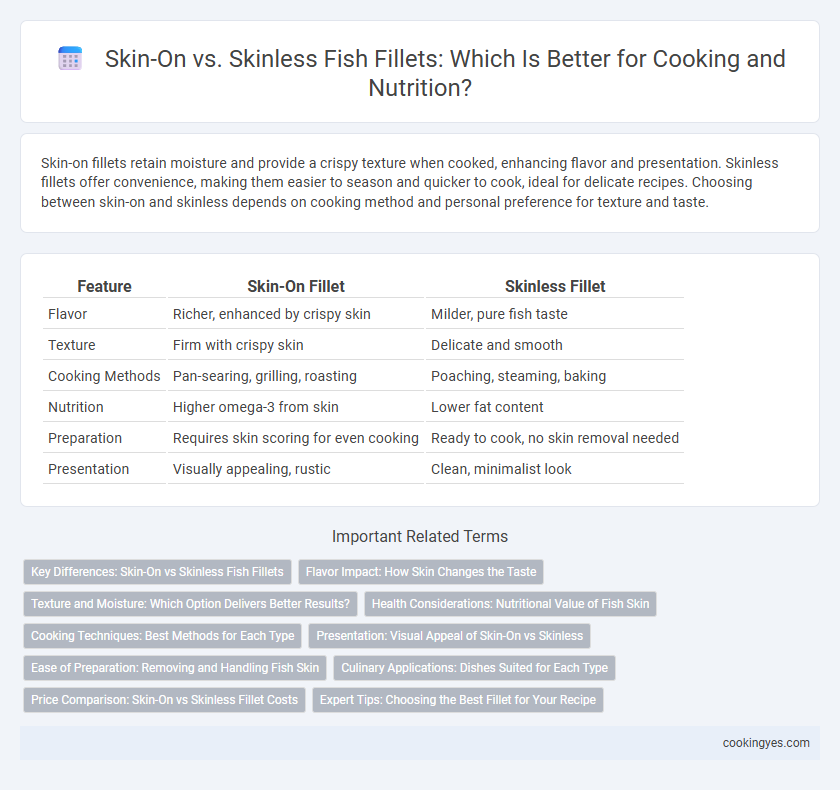Skin-on fillets retain moisture and provide a crispy texture when cooked, enhancing flavor and presentation. Skinless fillets offer convenience, making them easier to season and quicker to cook, ideal for delicate recipes. Choosing between skin-on and skinless depends on cooking method and personal preference for texture and taste.
Table of Comparison
| Feature | Skin-On Fillet | Skinless Fillet |
|---|---|---|
| Flavor | Richer, enhanced by crispy skin | Milder, pure fish taste |
| Texture | Firm with crispy skin | Delicate and smooth |
| Cooking Methods | Pan-searing, grilling, roasting | Poaching, steaming, baking |
| Nutrition | Higher omega-3 from skin | Lower fat content |
| Preparation | Requires skin scoring for even cooking | Ready to cook, no skin removal needed |
| Presentation | Visually appealing, rustic | Clean, minimalist look |
Key Differences: Skin-On vs Skinless Fish Fillets
Skin-on fish fillets retain the exterior layer, providing a protective barrier that helps preserve moisture and enhances flavor during cooking, especially when grilling or pan-searing. Skinless fillets offer convenience and a cleaner presentation, making them ideal for delicate recipes requiring gentle handling or quick cooking methods like poaching. The choice depends on desired texture, cooking technique, and presentation preferences, with skin-on delivering crispiness and skinless offering ease of seasoning absorption.
Flavor Impact: How Skin Changes the Taste
Fish fillets prepared with the skin on retain more natural oils and fatty acids, enhancing flavor depth and richness during cooking. The skin crisps up when seared, adding a savory texture that intensifies the overall taste profile. Skinless fillets, while delicate and easy to season, tend to lose some moisture and subtle flavors that are preserved by the skin barrier.
Texture and Moisture: Which Option Delivers Better Results?
Skin-on fish fillets retain more moisture during cooking, resulting in a juicier and more flavorful texture due to the protective barrier the skin provides. Skinless fillets tend to dry out faster and may lack the crispiness that skin imparts when seared or grilled. Choosing skin-on enhances the overall sensory experience by preserving both texture and moisture effectively.
Health Considerations: Nutritional Value of Fish Skin
Fish skin contains high levels of omega-3 fatty acids, which support heart health and reduce inflammation. It is also rich in collagen, promoting skin elasticity and joint health. Removing the skin can reduce calorie intake but may also diminish these nutritional benefits.
Cooking Techniques: Best Methods for Each Type
Skin-on fish fillets retain moisture and develop a crispy texture when pan-seared or grilled, providing a flavorful barrier that protects delicate flesh from overcooking. Skinless fillets are ideal for poaching, steaming, or baking, allowing even heat penetration and tender, flaky results without the need to crisp skin. Choosing the appropriate cooking technique enhances texture and flavor, ensuring optimal preparation for each fillet type.
Presentation: Visual Appeal of Skin-On vs Skinless
Skin-on fillets offer a visually striking presentation with a crisp, golden-brown crust that enhances the dish's texture and appeal. The skin provides a natural glossy finish and vibrant contrast to the tender flesh, making the dish more appetizing and restaurant-worthy. Skinless fillets present a cleaner, more uniform appearance suitable for minimalist plating where the focus is solely on the fish's color and flakiness.
Ease of Preparation: Removing and Handling Fish Skin
Skin-on fillets provide easier handling during preparation as the skin helps hold the flesh together, reducing the risk of tearing, while skinless fillets require careful handling to prevent damage due to their delicate, exposed flesh. Removing fish skin can be a time-consuming step that demands skill and the right tools, especially for thin or slippery fillets. For home cooks, choosing skin-on fillets simplifies the process by maintaining structure throughout cutting and cooking, minimizing the preparation effort.
Culinary Applications: Dishes Suited for Each Type
Skin-on fish fillets retain moisture during cooking and develop a crispy texture, making them ideal for pan-searing, grilling, and broiling dishes like salmon with crispy skin or pan-seared trout. Skinless fillets, which cook more evenly and have a delicate texture, are suited for recipes where smoothness is preferred, such as poached fish, fish tacos, or fish cakes. Chefs often select skin-on fillets for dishes emphasizing texture contrast and skinless for recipes highlighting tenderness and ease of seasoning absorption.
Price Comparison: Skin-On vs Skinless Fillet Costs
Skin-on fillets generally cost less per pound compared to skinless fillets due to reduced processing time and lower labor costs. The presence of skin helps preserve moisture and freshness, which can lead to less waste and better value for the price. Retailers often price skinless fillets higher to cover the additional deboning and skin removal processes involved.
Expert Tips: Choosing the Best Fillet for Your Recipe
Skin-on fillets retain moisture and flavor better during cooking, making them ideal for grilling, pan-searing, and roasting. Skinless fillets offer versatility and are preferred for recipes requiring delicate textures or quick cooking methods like poaching and steaming. Experts recommend selecting skin-on for crispy textures and skinless when you want the fish to absorb more marinade or sauce.
Skin-on vs skinless for fillet preparation Infographic

 cookingyes.com
cookingyes.com